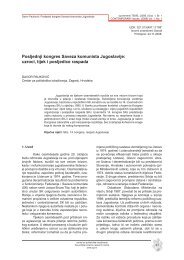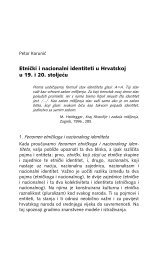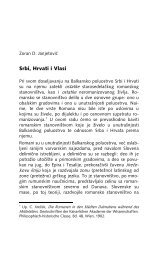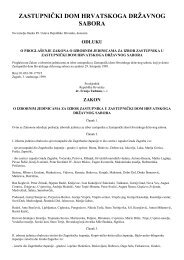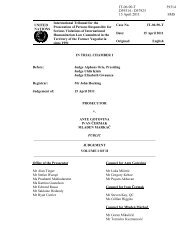ISSN 1847-2397 godište II broj 1 2009. | volume II number 1 2009
ISSN 1847-2397 godište II broj 1 2009. | volume II number 1 2009
ISSN 1847-2397 godište II broj 1 2009. | volume II number 1 2009
- No tags were found...
Create successful ePaper yourself
Turn your PDF publications into a flip-book with our unique Google optimized e-Paper software.
Sabina Stan: The Discourse on the “Crisis of the Health Care System”suvremene TEME, (<strong><strong>2009</strong>.</strong>) God. 2, Br. 1CONTEMPORARY issues, (<strong>2009</strong>) Vol. 2, No. 1constitutes itself into “a window to the fragility ofour system”. 11Thus, after 1998, the crisis is conceivedof as a quasi-permanent feature of the system. Ifin the spring 1998, there is a “very profound crisisthat touches the health care system”, 12 at thebeginning of 1999, there is a “perpetual state ofcrisis” 13 that in several months transforms itselfinto “the most profound crisis of the last ten years[assaulting] our health care system”. 14 At the beginningof 2000, the problems of the health caresystem are no longer “conjectural”, 15 and later itis restated that the health care system is in “apermanent state of crisis”. 16 One year later, oneis summoned to take notice of the crisis’ gravityand of “how profound a crisis our health caresystem goes through”. 17Thus, after 1998, a new vision of thecrisis develops, takes hold of media discourseand becomes the dominant way to qualify thesystem as a whole in this field. Indeed, now, discussionon the crisis is conducted in a matterof-factmanner that renders its existence evidentand natural. In the new vision, the crisis of thehealth care system is just there. It is a takenfor-granted,normal phenomenon, the existenceof which does no longer need to be proven, butonly, at most, illustrated. This generalisation andnaturalisation of the idea that the health caresystem is in crisis can be seen as indicative ofits institutionalisation and of its transformationinto a dominant vision of the present state of thehealth care system. 18This vision of the crisis supplies theframework for conceiving of the problems of thehealth care system (“the crisis”) as permanent,general and profound ones. But the crisis discourseoffers not only a framework for envision-11 Le Devoir, April 1, 2000: F412 Le Devoir, April 20, 1998: A113 La Presse, February 24, 1999: B314 Le Devoir, July 13, 1999: A615 Le Devoir, February 5, 2000: A1216 La Presse, March 24, 2000: B3; La Presse, June21, 2002: A1017 La Presse, May 23, 2001: A1618 The dominance of a new vision of the crisis isalso compounded, paradoxically, by the fact that voices thatcontest the existence of the crisis also intensify during theperiod 1998-2003. Marginal as they are (of the total articlesanalysed here, only nine include a negation of the crisis),these voices almost double their strength after 1998. Denialsof the existence of the crisis can be seen not so much as participatingin a powerful counter discourse, but more as merereactions to a powerful vision that imposes itself as the prismthrough which the health care system is read.ing the problems of the health care system; italso comprises visions of the causes of theseproblems.5. Articulations: The Causes of the CrisisIn order to grasp the manner in whichthe crisis discourse envisions the causes of thecrisis, I will make a couple of distinctions. On theone hand, I distinguish between causes externaland internal to the system, that is, betweencauses that lie in the system’s environment andcauses that lie in the functioning of the system.On the other hand, I also distinguish betweencauses that are seen in terms of agency (i.e.originating in the action of real, identifiable actors,such as, in this case, the government,pharmaceutical companies or physicians), andcauses that are seen in terms of abstract processesor entities (such as demographic andeconomic trends or “the structure”). Within thecrisis discourse, few voices seriously considerthe contribution of external factors to the developmentof the crisis. Among external factors,what we could call “external agents” is very marginal.In fact, only two articles explicitly see thecrisis as resulting from the actions of real, concreteagents – namely, the Quebec government,and physicians and pharmaceutical companies,respectively. 19 Among external causes, the pivotalplace is accorded not to identifiable agents,but rather to trends which are seen as inherentin the evolution of our contemporary societies.These are global trends that drive up health caredemand and thus health care costs: the ageingof the population, technological developments inmedicine, the invention of new drugs and newcontagious diseases like SARS (in 2003). It isdue to their sheer amplitude that these trendsimprint themselves on the health care system soas to render it “an abyss without bottom”. 20In this way, the crisis discourse takesa natural and abstract turn, as real agents thatcould be made accountable are discharged in favourof abstract forces for which nobody can beblamed. Thus, the crisis itself is rendered natural,ineluctable, caught in the current, given, orderof the world. As one article states, “the pressuresthat threaten us in the future [ensure that]we are heading for a crisis”. 21As external abstract causes are natu-19 Le Devoir, July 13, 1999: A6, Le Devoir, April 12,2003: B720 La Presse, May 23, 2001: A1621 La Presse, June 5, 2000: B2centar za politološka istraživanjathe political science research centrewww.cpi.hr22








